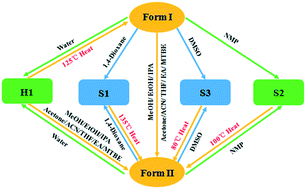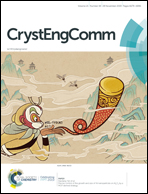Versatile solid forms of boscalid: insight into the crystal structures and phase transformations†
Abstract
Boscalid, a commonly used fungicide, is mainly used for controlling gray mold, powdery mildew, and sclerotia. The aim of this study was to investigate the solid forms of boscalid systematically. The powder production of two anhydrous polymorphs (form I and form II) and monohydrate (H1) has been reported in the literature, while three novel solvates, i.e. S1 (1,4-dioxane solvate), S2 (N-methyl pyrrolidone solvate) and S3 (dimethyl sulfoxide solvate) have been obtained for the first time. The physicochemical properties of these six solid forms were fully characterized including power X-ray diffraction, scanning electron microscopy, Fourier transform-infrared spectroscopy, solid-state NMR, and thermal analysis. The crystal structures of all the six solid forms were determined from the single crystal data. The molecule conformations and packing arrangements in the crystal structures were analyzed and compared. Hirshfeld surface analysis was applied to reveal the intermolecular interactions. The packing coefficients of the crystal forms have been calculated to explain the formation of solvates. Finally, the desolvation process of solvates and the transformation relationship between different phases were explored. Meanwhile, the desolvation of solvate S2 leads to form II suitable for practical applications.



 Please wait while we load your content...
Please wait while we load your content...